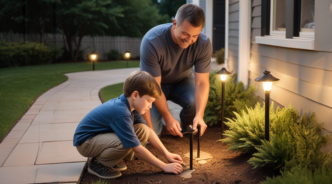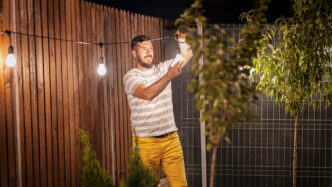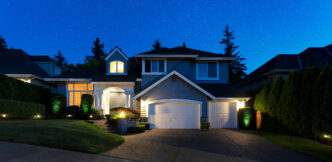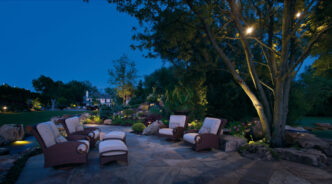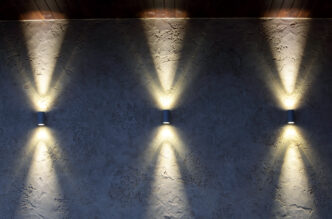Landscape lighting can transform your outdoor spaces into a stunning visual experience, adding both beauty and security to your home.
Whether you’re lighting up a garden, highlighting architectural features, or creating a welcoming entrance, the right tools can make all the difference.
In this guide, we’ll cover the essential landscape lighting tools you need to get the job done, providing you with tips and insights to make your project a success.
1. Planning and Design Tools
Before you start digging and installing, planning is crucial. Having a clear design and layout helps you achieve the desired effect and avoid costly mistakes. Here are some of the tools you need to plan the perfect landscape lighting setup.
Measuring Tools
Accurate measurements are vital for a professional-looking installation. Without precise measurements, you may end up with misaligned fixtures that ruin the aesthetic appeal of your lighting setup. This can lead to unnecessary adjustments, costing you extra time and potentially increasing labor costs. Additionally, mistakes in measurement can result in wasted materials, further driving up your expenses. Ensuring you measure correctly from the start helps you avoid these financial and time-consuming pitfalls, leading to a smooth and efficient installation process. These measuring tools will go a long way:
- Measuring Tape: A basic but essential tool for measuring distances.
- Laser Distance Measure: For quick and precise measurements over longer distances.
- Graph Paper and Ruler: For sketching out your plan by hand.
2. Installation Tools
Once you have your plan, it’s time to gather the necessary installation tools. Here are the must-haves:
Shovels and Trenching Tools
Digging trenches for wires and fixtures is hard work, but the right tools can make it easier. These tools are essential for installing fixtures into the ground, such as pathway lights, in-ground spotlights, and garden lights.
- Spade Shovel: Ideal for digging holes for larger fixtures.
- Trenching Shovel: Narrower than a spade, perfect for digging trenches for wiring.
- Trench Digger: For more extensive projects, a powered trench digger can save time and effort.
Wire Strippers and Cutters
Proper wiring is crucial for a safe and effective lighting system. Wire strippers and cutters are essential for preparing and customizing wires for various fixtures, such as deck lights, wall lights, and pathway lights, ensuring that your connections are secure and that your landscape lighting setup is both functional and professional. These will come in handy:
- Wire Strippers: For removing insulation from the ends of your wires.
- Wire Cutters: Essential for cutting wires to the correct length.
- Cable Staples: To secure wires in place and keep them tidy.
Drills and Drill Bits
A versatile drill is indispensable for installing fixtures on hard surfaces such as walls, decks, and trees. Whether you’re mounting accent lighting on your home’s exterior, installing spotlights on trees, or securing fixtures to your deck, a reliable drill and the appropriate drill bits are vital. Having these tools on hand is vital:
- Cordless Drill: Offers flexibility and ease of use.
- Masonry Bits: For drilling into concrete or brick surfaces.
- Spade Bits: For drilling larger holes in wood or softer materials.
Wrenches
Wrenches come in handy whenever you are assembling and tightening various lighting fixtures. From securing mounting brackets to adjusting fixture angles, wrenches ensure that your lights stay firmly in place and are properly aligned. Keep these wrenches nearby:
- Adjustable Wrench: Perfect for tightening bolts and nuts on lighting fixtures.
- Socket Wrench Set: Useful for more specific fittings that require different sizes.
3. Electrical Safety and Monitoring Tools
Safety first! Electrical work can be dangerous, so having the right tools is non-negotiable. Electrical safety and monitoring tools ensure that your landscape lighting is not only beautiful but also safe to operate. Set yourself up for success by having the following tools.
- Voltage Tester: A voltage tester ensures that your wires are not live before you start working on them, preventing shocks.
- Multimeter: A multimeter helps you measure voltage, current, and resistance, ensuring your connections are correct and safe.
- Circuit Finder: This tool is useful for identifying circuits and breakers, especially in complex installations.
4. Fixture-Specific Tools
Different landscape lighting may require specialized tools for installation and maintenance. Having the right tools for specific fixtures ensures that your installation is smooth to set up and your landscape lighting works like a charm. Have these fixture-specific tools around when you’re working:
- Mounting Brackets and Screws: Ensure you have the correct mounting hardware for your fixtures. Some fixtures come with their own brackets and screws, but having a variety on hand can be helpful.
- Hex Keys and Screwdrivers: Many fixtures use hex screws or specific types of screws, so a set of hex keys and screwdrivers is essential.
5. Reach and Safety Tools
When working on higher areas or hard-to-reach places, proper tools and safety gear are essential. These tools help you safely install and maintain lights in elevated or difficult-to-access spots, such as tree-mounted lights, second-story fixtures, and other high areas.
- Step Stool: For reaching lower heights safely.
- Extension Ladder: For accessing higher spots, such as tree-mounted lights or second-story fixtures.
- Telescoping Ladder: Offers flexibility in height and is easy to store.
6. Finishing Tools
Once your fixtures are installed, a few finishing touches can make a big difference. These tools help you protect and enhance your lighting setup, ensuring a polished and professional appearance.
- Cable Covers and Conduits: Protect and tidy up your cables with covers and conduits. They prevent damage and give a cleaner look to your installation.
- Mulch and Gravel: Covering your trenches with mulch or gravel not only protects the wires but also enhances the aesthetics of your garden or yard.
7. Maintenance Tools
To keep your landscape lighting in top shape, regular maintenance is key. These tools help you maintain your fixtures, ensuring they remain in working order and look visually appealing as opposed to headache-inducing.
- Soft Brushes and Cleaning Cloths: Fixtures can become dirty over time. Soft brushes and cleaning cloths help you clean them without causing damage.
- Replacement Bulbs: Having a stock of replacement bulbs ensures your lighting remains consistent and prevents dark spots in your design.
8. Safety Gear
Landscape lighting can be dangerous, especially since there are so many scenarios that require caution. Don’t overlook safety. Safety gear is essential for preventing injuries and ensuring a safe working environment. Protect yourself while working by wearing the following gear.
- Gloves: To protect your hands from sharp objects and electrical hazards.
- Safety Glasses: To shield your eyes from debris and sparks.
- Knee Pads: For comfort when you’re working on the ground.
- Helmet: For head protection, especially when you’re working under trees or on ladders.
Pro Tips for Successful Landscape Lighting
Ready to take your landscape lighting project to the next level? Our pro tips are here to help you achieve stunning, professional results.
Whether you’re just starting out or looking to refine your skills, these expert insights will ensure your outdoor spaces shine beautifully and efficiently. Dive in and discover how to create a captivating and well-lit environment with ease!
- Start Small: Begin with a few key areas to light, such as your entryway or a standout garden feature. As you become more comfortable with the process and see how the lights enhance your space, you can expand your lighting to other areas. This approach helps you manage your budget and workload while allowing you to make adjustments based on your initial results.
- Test Before Final Installation: Temporarily place your lights and test them at night to ensure you’re happy with the effect before you start digging or drilling holes. A great way to test is by using wood blocks to prop up the lights, allowing you to easily adjust and reposition them until you achieve the desired look.
- Use LED Bulbs: LED bulbs are energy-efficient, long-lasting, and come in a variety of color temperatures to suit your design. They produce less heat, reducing the risk of fire and are more durable, which is perfect for outdoor use. Plus, LEDs can provide the same level of brightness as traditional bulbs while consuming significantly less power, making them an eco-friendly choice.
- Check Local Codes: Ensure your installation complies with local building and electrical codes to avoid fines and ensure safety. This might include regulations on the type of fixtures you can use, the depth of buried wires, and specific electrical standards. Checking these codes beforehand can prevent costly mistakes and ensure your lighting setup is safe and legal.
- Consult a Professional: If you’re unsure about any aspect of your installation, don’t hesitate to consult a professional electrician. Professionals can provide valuable insights and ensure that your installation is safe, efficient, and up to code. They can also help with complex tasks, such as installing transformers or connecting to the main power supply, which might be beyond the scope of a DIY project.
Illuminate Your Outdoor Space Like an Expert
Landscape lighting can elevate your outdoor space, making it more beautiful, secure, and enjoyable for you and your family.
By equipping yourself with the right tools and following best practices, you can achieve professional results and create a stunning lighting display that will impress for years to come.
Join our Insider list and check out the different landscape lighting tools that we have to offer.
